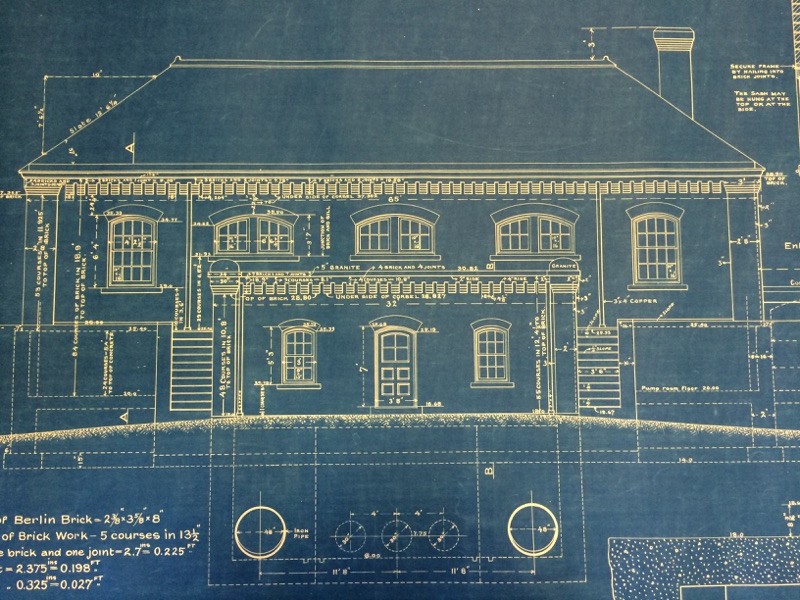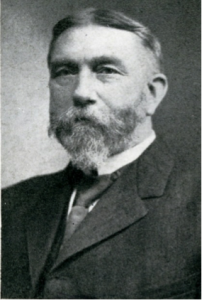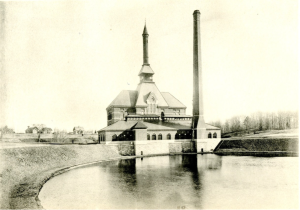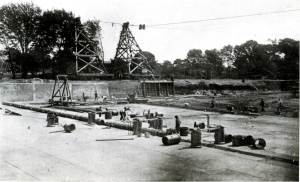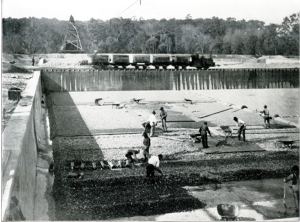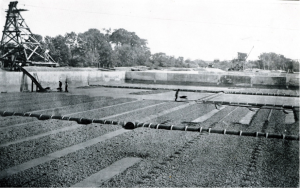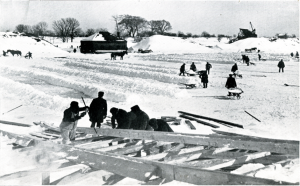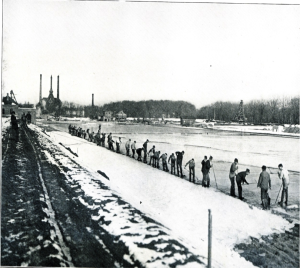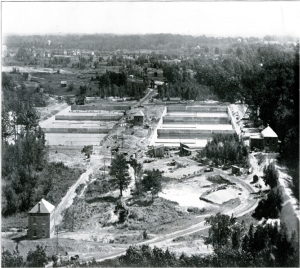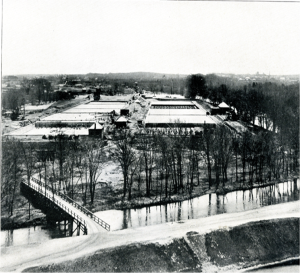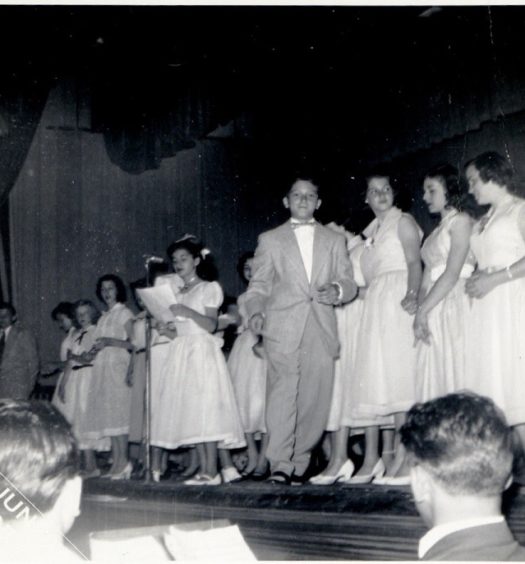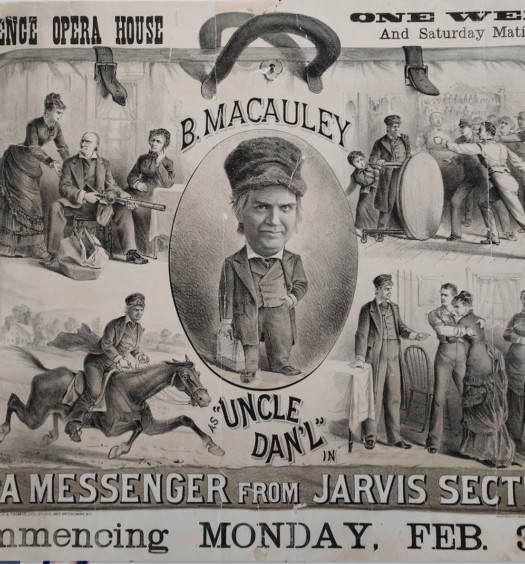How did plans for a century old Providence water filtration plant end up in the collections of the Lawrence Public Library in Massachusetts? We may never know, but thanks to a generous offer by their Special Collections Librarian, Louise Sandberg, the plans are now back in Providence as a new addition to the City Archives’ large collection of blueprints and building plans. The set of blueprints, developed under the supervision of Providence City Engineer Otis Clapp in 1902, detail the construction plans for a “slow sand filtration plant” in the Sockanosset Hill section of Cranston, not far from present day Garden City.
Providence’s first major effort to supply water to its rapidly growing population began in 1866 when the city was given Rhode Island General Assembly approval to tap the waters of the Pawtuxet River as a source of drinking water for its residents. Two years later, Providence acquired the 96-acre Aldrich Farm in Cranston which had river frontage and bordered on Pontiac Road. It had the added advantage of being located near Sockanosset Hill which, at 180 feet above tidewater, allowed water stored there to be gravity fed into the city. By 1871, a pumping plant had been constructed on the western edge of the former Aldrich Farm and on Thanksgiving Day 1871 water service was initiated to city residents and businesses. The Board of Water Commissioners at that time declined the suggestion to add filtration since “no city in the United States is supplied with filtered water, and no city of much size with water as pure as Pawtuxet.”
By 1900, however, the growing number of industrial uses along the Pawtuxet River and consequent population expansion began to have an adverse effect on water quality. An expense that the Water Commissioners had avoided in 1870 now became a necessity. As a consequence, in 1902 the city approved construction of a “slow sand” filtration plant, and that July workers began clearing land just below the existing Pettaconsett Pumping Station. The project called for the installation of six one-acre filtration beds on the opposite side of the river from the pumping station. The new filtration plant was constructed on the edge of the river bank. Two pumps there drew raw river water about seven feet from the Pawtuxet River, which was then passed through the filtration beds and then sent to a water storage basin near the pumping station.
Acquiring quality sand for the filtration beds slowed progress on the project, but on November 6, 1905 filtered water began arriving in Providence households. Of course, merely relying on sand filtration to remove impurities in water to be used in households would not be an acceptable practice today, but then it was done. The onset of winter, however, began causing problems when the filter beds began to ice up requiring a small army of workers to clear off surface ice and occasionally remove snow. A short time later, protective covers were placed over the beds to mitigate the effects of cold and snow.
By 1907, more than 16 million gallons of Pawtuxet River was processed through the filter beds each day. But even with these improvements, the limitations of drawing water from the Pawtuxet River to accommodate the city’s expanding industries and explosive population growth became apparent. During the ten year period between 1900 and 1910 Providence’s population grew by nearly 50,000 to 224,326 residents (the city’s current population is approximately 178,000), and between 1900 and 1907 the city’s daily water needs grew from 10.1 million gallons to more than 16 million gallons—an increase of 60% in just seven years.
On January 7, 1913 a special committee was created by the Providence City Council to analyze the current and future water needs of the city. Its study concluded that the current system of obtaining water from the Pawtuxet River was insufficient to accommodate continued growth trends forecast for the city. Two years later, the state general assembly approved the creation of the Providence Water Supply Board with authority to construct a reservoir in rural Scituate. This mammoth infrastructure project called for the damming of the north branch of the Pawtuxet River and the highly controversial inundation of four villages. The Scituate Reservoir, with a storage capacity of 37 billion gallons and daily output nearly five times greater than the former system, became operational on September 30, 1926.
With the new Scituate Reservoir in place, the old Pettaconsett Pumping Station and the nearby filtration beds were abandoned. The site is currently occupied by a sewerage treatment facility and a small business park. Although swept way from the local landscape by the relentless tide of progress, the slow sand filtration plant’s important place in supporting the city’s growth and development lives on in the detailed engineering drawings kept safe from the ravages of time by the Lawrence Public Library and now back home in Providence.
(Banner image: Original blueprints for a Slow Sand Filtration Plant, dated 1902)

Special Collections Librarian Louise Sandberg gifting original plans to Paul R. Campbell, City Archivist
Bibliography
Primary sources for this article are the following Providence City Documents: City Engineer’s Reports for the years 1901-1909 and Resolutions of the City Council, 1913. John Hutchins Cady’s book, The Civic and Architectural Development of Providence, 1636-1950 (Providence: The Book Shop, 1957) is an excellent and reliable source for information on the development of Providence’s infrastructure. Population data was obtained from Patrick T. Conley and Paul R. Campbell, Providence: A Pictorial History (Norfolk, VA: The Donning Company, 1982). All photographs are from the graphics collections housed at the Providence City Archives.

